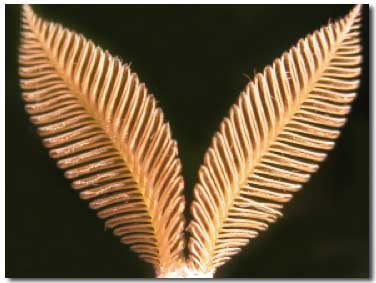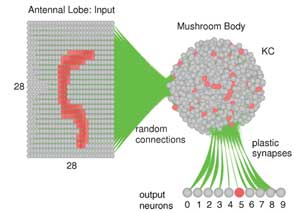Olfactory orientation
Part 3: Learning and evolution
Flower foraging insects can visit dozens of flowers per day and the insects quickly learn to associate the colour, shape, texture and odour of certain flowers with a nectar reward. The associative memories are plastic and change with the insect’s changing experience. The mushroom bodies (MB) are the areas of the insect CNS shown to be involved in memories. The CNS releases the brain chemicals octopamine and dopamine when sensory stimuli are associated with concurrent reward or punishment. These brain chemicals can modify neural activity within the MB, strengthening or weakening the connections between active/inactive cells.

|
This diagram is of a basic model system: 28x28 input neurons are randomly connected to 50,000 Kenyon cells. These are read out by 10 output nefurons in the MB lobes. The output neurons are connected to all KCs with fairly homogeneous initial weights. Subsequently, these connections are modified by learning." Diagram and text from Huerta R & Nowotny T (2009) Fast and Robust Learning by Reinforcement Signals: Explorations in the Insect Brain, Neural COmputation 21: 2123-2151. |
More detail on learning follows in a later topic (Memory & Learning module).
There is strong selection pressure for physiological and behavioural mechanisms that result in the successful location of resources at appropriate times, as these insects are more likely to survive, mate and produce progeny. It is important to remember that the olfactory system’s main function is to capture changes in an insect’s odour environment and guide it toward resources or away from danger. It has evolved the ability to detect key odorants such as pheromones with high sensitivity. Compared to pheromone systems, there are many more compounds in host produced mixtures, and their ratios are more variable. Here, selection probably favours robust adaptable systems rather than finely tuned specialized ones.
For more detail see de Bruyne M & Baker TC (2008) Odour detection in insects: Volatile codes, Journal of Chemical Ecology 34: 882-897 doi: 10.1007/s 10886-008-9485-4
However, even so called ‘generalist’ ORNs are now considered to be more specific than was previously thought. Read this recent article from Biotechniques.com.
The evolution of pheromone communication systems is thought to be driven by changes in the biosynthesis of pheromone components that are tracked by shifts in male olfactory response. Major shifts in moth pheromone blends have been hypothesized to occur when previously unexpressed desaturase genes become expressed in the pheromone glands of some females in a population.
For more detail see Roelofs WL et al. (2002) Evolution of moth sex pheromones via ancestral genes, Proc. Natl. Acad. Sci. USA 99: 13621–13626 doi:10.1073/pnas.152445399
If a few males in the population are able to respond to both the new and old blend, a new population of males and females communicating with this new blend would be formed through a process of asymmetric tracking over generations by males. For this to occur, tuning properties of pheromone sensitive ORNs would have to show a degree of variability for selection to act upon. However, even in highly specialised systems such as moth sex pheromone attraction, plasticity of behavioural responses can occur due to changes in the organisation or functioning of neural networks in the antennal lobes and CNS.
 Activity:
Activity:
Think about olfactory orientation in bees or another insect of your choice. Try and work out any precursors to orientation and the behavioural mechanism(s) involved.

